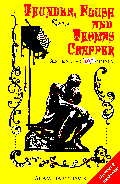Thunder, Flush and Thomas Crapper: W
^UP^ to Thunder, Flush and Thomas Crapper index.
Chapters: A B C D E F G H I J K L M N O P R S T U V W Y Z

Extracts from Adam Hart-Davis's book.
(Buy the book from Micheal O'Mara Books, ISBN 1-85479-250-4, hardback 1-85479-245-8, or in the US, ISBN 1570760810.)
- Wash-Down Closets
-
 The main rival to the wash-out closet,
and a simple development of the hopper, is
the wash-down closet. The flushing water, released
from under the porcelain rim, cascades down all around the
bowl and sweeps all before it through the s-bend at the
bottom---or at least that is the theory. In practice the exact
shape of the bowl and the arrangement and force of the flush
sometimes prevent it from working as well as it should; by the
time the water reaches the bottom it is flowing slowly, and the
walls may stay smeared.
The main rival to the wash-out closet,
and a simple development of the hopper, is
the wash-down closet. The flushing water, released
from under the porcelain rim, cascades down all around the
bowl and sweeps all before it through the s-bend at the
bottom---or at least that is the theory. In practice the exact
shape of the bowl and the arrangement and force of the flush
sometimes prevent it from working as well as it should; by the
time the water reaches the bottom it is flowing slowly, and the
walls may stay smeared.
Also the faeces have a long way to fall, which probably causes more noise and splashing than in wash-out closets. Nevertheless the wash-down is now by far the most common lavatory in Britain; so in Darwinian terms it must be the fittest for its UK purpose.
- Wash-Out Closets
-
Common today in Germany,
France, and North America, the wash-out or flush-out closet is
low and long, with a shallow pool of water at the back and a
platform in front of it. Flushing produces an energetic jet of
water from the back, which drives any offering out over the
plateau and into the trap below, whence it is removed by the
flow and in some cases by siphonic action. A clear advantage of
this design is that the faeces have only a short way to fall. This
should mean less noise, and less splashing.
Disrespectful travellers have suggested that flush-out closets have a flat platform because the French and Germans are obsessive about wanting to examine their stools. In practice this design allows a sharp undercutting surge of water cleanly to remove even sticky excrement more efficiently than in any wash-down design. Furthermore the wash-out closet was patented in Britain by George Jennings in 1852, which is probably well before it appeared in Germany or France.
- Water-Closets
-
The OED says a water-closet is "a closet
or small room fitted up to serve as a privy, and furnished with
water supply to flush the pan and discharge its contents into a
waste-pipe below. Often abbreviated W.C." The term has been
in use since 1755.
People seem to have been flushing lavatories with water for at least 4,000 years (see history), and the Romans had flushing latrines in England 2,000 years ago---although technically their latrines did not have separate pans---so it seems foolish to claim that the water-closet was invented by one particular person.
A self-contained water-closet was made by Thomas Brightwell of the parish of St Martin in 1449, but we don't know much about it, except that it was flushed by rainwater, collected in a lead cistern; see also the Abbot of St Albans. For the earliest one we do know about---1596---see Harrington.
The first patent for a water-closet was taken out by Alexander Cumming in 1775, and his sliding-valve device was improved by Joseph Bramah in 1778. See also Crapper.
- Women's Room (The)
-
Marilyn French's novel The Women's Room is one of the most famous
novels of the Women's Liberation Movement. It begins:
Mira was hiding in the ladies' room. She called it that, even though someone had scratched out the word ladies in the sign on the door, and written women's underneath. She called it that out of thirty-eight years of habit, and until she saw the cross-out on the door had never thought about it. "Ladies' Room" was a euphemism, she supposed...
But here she was at the age of thirty-eight, huddled for safety in a toilet booth at the basement of Sever Hall... She was perched, fully clothed, on the edge of the open toilet seat, feeling stupid and helpless, and constantly looking at her watch.
Text extracts from "Thunder, Flush and Thomas Crapper" copyright (c) Adam Hart-Davis 1997. Web extracts first published 2007-07-18, updated ✎2018-02-25
Images available from the DHD Multimedia Gallery.
Site content copyright (c) Damon Hart-Davis 1997--2018 unless otherwise stated.
Hosted by ExNet.